Spine surgery for lower back pain revives young woman’s life

11/30/2023
Excruciating lower back pain prevented a young woman from living her life to the fullest. She got her life back after spine surgery.
“I had back pain for years. I was a teenager the first time I had severe back pain,” Carolina said.
After countless doctor visits, pain management attempts and physical therapy sessions, Carolina had just about accepted she had to live with back pain.
“Good days were when my pain level was a six out of 10. The worst days were when I could not walk,” Carolina said.
Feeling physically debilitated and emotionally frustrated, she decided to try one more spine specialist — a decision that changed her life.
Living with debilitating lower back pain
Carolina cannot pinpoint a specific injury that might have caused her back pain. Although, she was an equestrian competitor and said, “I fell off a horse more times than I can count.”
Carolina loved horseback riding, but it was difficult to continue when she went to college. That is when she took up running.
“Unlike horseback riding, you can run anywhere and explore new places, which is what I loved about it.”
For many years, Carolina tried different remedies to feel better, including muscle relaxants, over-the-counter pain medications, physical therapy, massage therapy, Pilates and yoga.
Despite everything she tried, Carolina said, “My back got worse and worse.”
In addition to sharp pain in her lower back, Carolina had weakness in her legs and sometimes had pain in her hips.
Over time, back pain took away the things Carolina enjoyed most, including running, hiking and riding a motorcycle.
She used to run marathons and half marathons but had to give up running for about five years.
“In 2017, I hobbled across the finish line at the New York City Marathon — my last marathon. I thought, ‘I am done running, I cannot do this anymore,’ ” Carolina said.
Eventually, back pain even hindered her ability to complete daily activities without discomfort.
“When I traveled, I had to carefully plan my luggage so it was not too heavy and use elevators to get around,” Carolina said, which someone in their 30s should not have to worry about.
“I was in so much pain I could not sleep at night,” Carolina said. “I do not remember a day before surgery when I was pain-free.”
Related content: Know when to get spine treatment for back and neck pain
Spine surgery for severe lower back pain from degenerative disc disease
In addition to the physical toll of her back pain, Carolina was feeling discouraged and dismissed.
Carolina has a Ph.D. and is a professor of social work at a university in New York City. She saw several different doctors when she was living in the city.
“Most doctors I saw told me my back pain was not that bad. Some said I was too young to feel that kind of pain and should just do yoga. Others said it was because I was getting older. A spine surgeon I had never seen in person wanted to rush me into surgery after reviewing imaging of my back that was two years old — it was confusing!” Carolina said. “I was tired of going to doctors and thought it was just something I would have to live with.”
Carolina moved to Norwalk, Connecticut, after the COVID-19 pandemic. After she moved, she started having some other health concerns and went to see a primary care provider.
Dr. Amy Lohman, a Nuvance Health Medical Practice family medicine physician at the time, suggested Carolina see neurosurgeon Dr. Scott Sanderson.
Carolina was reluctant to try another spine doctor but decided to see Dr. Sanderson because of Dr. Lohman.
“After years of dealing with pain and symptoms, I finally felt like someone was listening and putting me in touch with the appropriate people,” Carolina said.
She was also deteriorating.
“Some days I could not even walk,” Carolina said.
Related content: What type of spine surgery is right for me?
Neurosurgery consultation
Carolina was pleasantly surprised after meeting Dr. Sanderson.
“Dr. Sanderson explained everything clearly and gave me options with no expectations or pressure to have surgery. He made me feel very comfortable and supported,” Carolina said.
Carolina said she fully understood what was happening in her back after meeting with Dr. Sanderson. He ordered new imaging, including an MRI, and explained what it showed in detail.
“Dr. Sanderson said I had a structural issue that no amount of yoga would fix,” Carolina said. “He said a disc between vertebrae in my lower back was like a water balloon with a hole in it. The water leaked out and only the flat balloon was left.”
Related content: Woman with cancer bounces back after two spine surgeries for herniated disc and bone spur
“Carolina had degenerative disc disease between L4 and L5 vertebrae. The disc dissolved enough that the vertebrae were rubbing together and causing pain in her lower back,” said Dr. Sanderson, chief of neurosurgery for Danbury Hospital, part of Nuvance Health.
Discs are cushions that sit between each vertebra in the spine. They are rubbery on the outside with a jellylike substance inside.
“Most people with disc problems have nerve pain such as sciatica and other symptoms in their arms or legs, including numbness, tingling or weakness. Based on these symptoms, we can usually detect exactly where the issue is in the spine and fix it. Pinpointing the cause of pain when it is isolated to the back is much harder,” Dr. Sanderson explained.
“Pain in the back is like a pebble hitting a windshield; it causes an initial crack and then spiders out. Someone might have trauma in one area of the spine and then the problem spreads throughout it. That is why it is difficult to know what to fix when the pain is only in the back. Also, fixing the initial problem may not relieve pain in other areas of the back,” Dr. Sanderson said.
“Carolina was unique and a good candidate for surgery based on the imaging results, her symptoms and the fact that she tried many non-surgical options without relief,” Dr. Sanderson said. “The imaging showed she did not have degeneration in other areas of her spine.”
“Even speaking to the staff at Dr. Sanderson’s office was validating. They noticed how long it took me to put on the gown for the exam and sit down and stand up. I had been living like that for years and started to think it was normal — apparently, it is not!” Carolina said.
Related article: Do these five things before your first visit with a surgeon for spine pain
As a professor and researcher, Carolina researched Dr. Sanderson and the spine surgery he recommended.
“I scoured the internet about Dr. Sanderson. Everything I read made me feel more confident,” Carolina said.
Spinal fusion surgery
Carolina had spinal fusion surgery in July 2022.
“I felt nervous going into surgery because if anything went wrong, it could affect my ability to walk,” Carolina said. “But I also felt supported by everyone involved. Everyone who came into my room before surgery explained what they were going to do and why, and that helped calm my nerves.”
Dr. Sanderson recommended Carolina have an extreme lateral interbody fusion (XLIF).
During the minimally invasive spinal fusion surgery, he accessed Carolina’s spine through small incisions on the left side of her body to avoid operating through major muscles, bones and ligaments in the back.
He removed the damaged disc, replaced it with an implant and then fused the vertebrae to stabilize the spine.
XLIF usually results in less pain, a shorter stay in the hospital and faster recovery for people compared to traditional spinal fusion surgery.
Recovering from spinal fusion surgery for lower back pain
After surgery, Carolina said she could feel an “immediate difference.”
“Even though I had expected post-surgery pain, the pain I had been feeling for years was completely gone,” Carolina said. “I thought, ‘I am already feeling better, I can get through this,’ ” Carolina said.
“That gave me the most hope; I knew things were going to change in my life,” Carolina said.
Carolina recovered at Norwalk Hospital a few days after surgery.
She started to feel a little better from surgery about two days after the operation.
“It was difficult to get in and out of bed, but I was able to walk a few steps with a walker,” Carolina said.
Carolina got progressively better the first two weeks after surgery. During that time, she needed assistance with most things, including getting into the shower, preparing food and taking care of her cat, which was difficult for her because she is a determined, independent person. She also had to sleep in a recliner.
“I do not usually allow people to take care of me. But I was so appreciative of Dr. Sanderson and did not want to mess up his work, so I did not push it,” Carolina said. “I watched Netflix and ate crackers and cookies.”
At her two-week post-op appointment, Dr. Sanderson said Carolina could start walking and driving.
“That was really good news,” Carolina said.
She started to get stronger and realized it when her legs were not giving out as they were before surgery.
Carolina said Dr. Sanderson also suggested she do planks to help her heal by strengthening her core.
“I thought I could hold a plank forever, but I could not hold myself up for even a second at first. I kept trying and could hold it for five seconds and then longer,” Carolina said. “My body was starting to work well again.”
In October, just a couple of months after spine surgery, Carolina was able to pack and move to a new home, which she decorated with a seven-foot-tall Christmas tree in December.
In November, Dr. Sanderson said she could ease into running.
“I used an app program for how to start running again after an injury. I started with walk/runs and slowly increased distance and speed,” Carolina said. “Dr. Sanderson said one of the biggest issues he sees with runners is re-injury, so I tried not to push myself too far too fast.”
Related content: Tips from a neurosurgeon: How to lead a balanced life
Running free after spinal fusion surgery for lower pain
“My main goal from surgery was not to be in excruciating pain,” Carolina said. “I just wanted to do normal activities without pain, like get dressed and take care of my cat. I was not sure if I could ever run again.”
To her pleasant surprise, Carolina said she is “really grateful” to be able to do things she thought were not possible before surgery.
Related content: Dad dances all night at daughter’s wedding after spine surgery
The year 2023 has been full of memorable milestones for Carolina.
She started riding her motorcycle again in May. She also took up tennis.
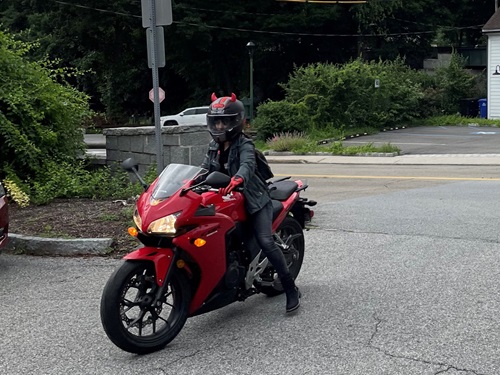
Carolina on her motorcycle
“I reached the summit of Mount Kilimanjaro exactly one year after surgery. It took seven days and my back felt great,” Carolina said.

Carolina hiking Mt. Kilimanjaro
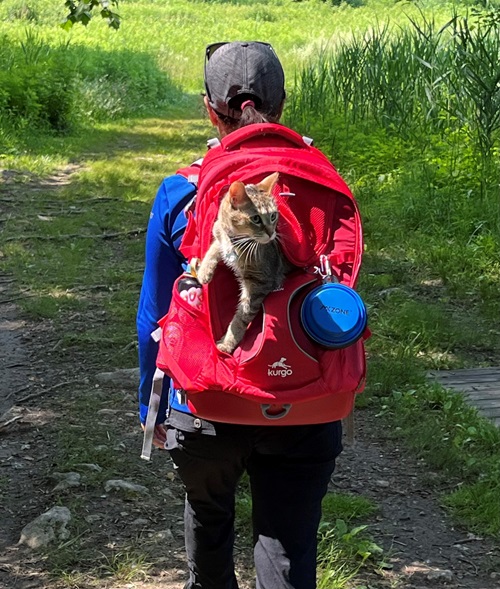
Carolina hiking with her cat
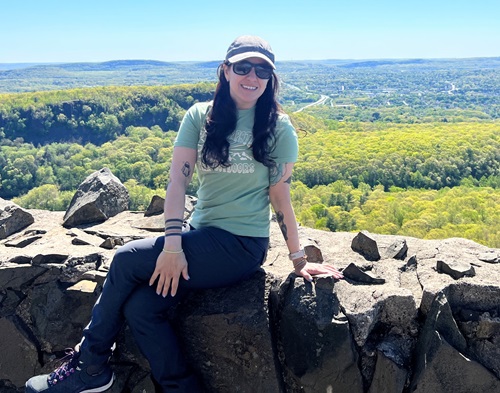
Carolina at the peak of a hike
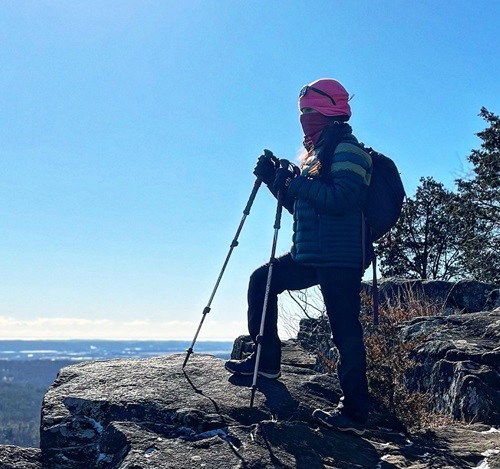
Carolina at an overlook during a hike
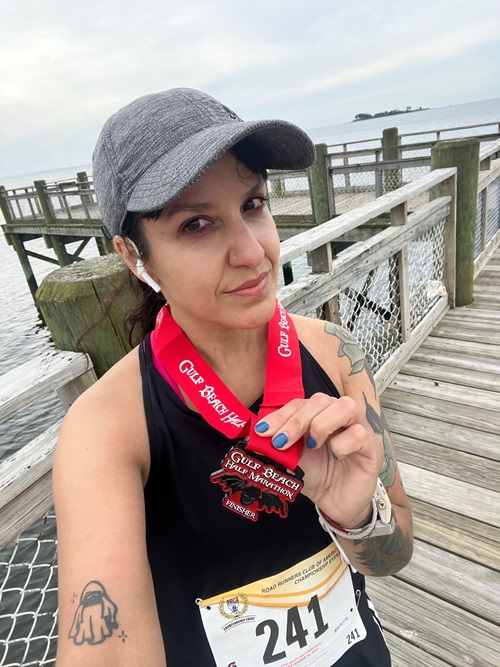
Carolina after running the Gulf Beach Halk Marathon in September 2023
“I got back parts of my life I thought were over,” Carolina said.
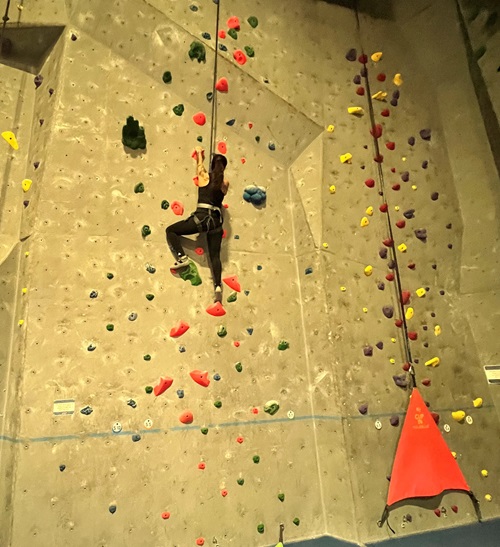
Carolina showcasing her indoor rock climbing abilities
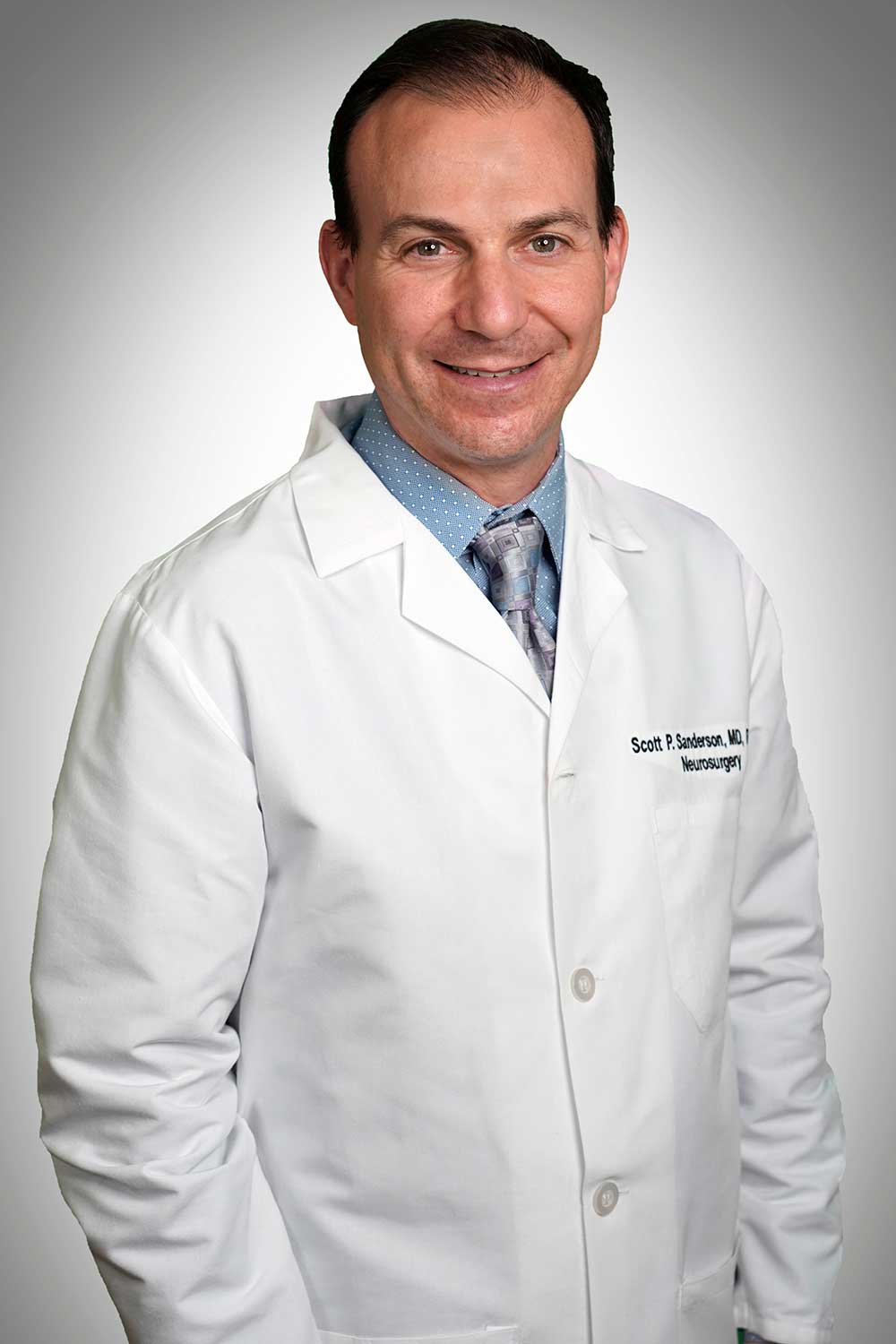
Recent News
Man Feels “Lucky” Brain Aneurysm was Found and Treated Without it Rupturing
Man Feels “Lucky” Brain Aneurysm was Found and Treated Without it Rupturing 08/19/2021 Unruptured brain aneurysms may have no symptoms until they burst and cause a life-threatening medical emergency Milton Reyman, a 66-year old from New Milford, Connecticut, felt...
Dad Dances All Night at Daughter’s Wedding After Spine Surgery
Dad Dances All Night at Daughter’s Wedding After Spine Surgery 08/10/2022 William Green had excruciating pain and could barely walk from a lower back injury William Green, 64, had terrible pain from his lower back shooting down his left leg. It was affecting his...
Woman With Cancer Bounces Back After Two Spine Surgeries for Herniated Disc and Bone Spur
Woman With Cancer Bounces Back After Two Spine Surgeries for Herniated Disc and Bone Spur 02/21/2023 Nuvance Health neurosurgeon designs the least invasive spine surgeries possible due to Randi Rote’s history of multiple myeloma, spinal stenosis and a life-threatening...
Two-Year-Old Narrowly Survives Emergency Brain Surgery During COVID-19 Pandemic
Two-Year-Old Narrowly Survives Emergency Brain Surgery During COVID-19 Pandemic 03/29/2021 The list of things scarier than a pandemic caused by an unknown virus is short. For Claire and Mark, on that list is their two-year-old son undergoing emergency surgery for a...
Cancerous Brain Tumors Finding Shocks Woman Whose Husband Also has Brain Cancer
Cancerous Brain Tumors Finding Shocks Woman Whose Husband Also has Brain CancerNorwalk, Connecticut, August 26, 2021 — After 49 years of marriage, Jayne Davis said, “My husband Frank and I are like mac and cheese. Not the same, but similar.” This oddly rang true when...
Twenty-Two Year Old Stroke Patient from Norwalk Hospital Makes Full Recovery
Twenty-Two Year Old Stroke Patient from Norwalk Hospital Makes Full RecoveryNORWALK, Connecticut, October 17, 2018 — Twenty-two year old Sawyer Gaines suddenly couldn’t move his right arm. He was light headed, and felt like he was drifting away. He knew something was...